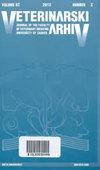Development of SYBR Green I-based quantitative PCR assay for identification of porcine circovirus 1, 2 and 3
IF 0.3
4区 农林科学
Q4 VETERINARY SCIENCES
引用次数: 0
Abstract
Porcine Circovirus (PCV) includes Porcine Circovirus 1(PCV1), Porcine Circovirus 2 (PCV2) and Porcine Circovirus 3 (PCV3). In recent years, co-infection exists between PCV1, PCV2 and PCV3 serotypes. Therefore, it is particularly necessary to establish a fast, specific and sensitive SYBR Green I real-time quantitative PCR detection method for PCV1, PCV2 and PCV3. In this experiment, specific primers were selected and the reaction conditions were optimized. A real-time quantitative PCR identification method was established. The results showed the detection limits of this assay were 40.3 copies/μl for PCV1, 25.2 copies/μl for PCV2 and22.4 copies/ μl for PCV3. There was no cross-reactivity with swine fever virus (CSFV), porcine reproductive and respiratory syndrome virus (PRRSV), porcine pseudorabies virus (PRV) and porcine parvovirus (PPV). The intra-assay and inter-assay coefficients of variation were less than 1%. The test results of 100 PCV suspected positive samples revealed that the PCV1, PCV2 and PCV3 singular infection rate was 10% (10/100), 64% (64/100) and 52% (52/100), respectively. The PCV1 and PCV2 co-infection rate was 8% (8/100), the PCV1 and PCV3 co-infection rate was 7% (7/100), the PCV2 and PCV3 co-infection rate was 26% (26/100), and the PCV1, PCV2 and PCV3 co-infection rate was 7% (7/100). This method has good specificity, sensitivity and stability. It provides a promising tool for rapid differential detection of PCV1, PCV2 and PCV3.基于SYBR Green i的猪圆环病毒1、2、3型定量PCR方法的建立
猪圆环病毒(PCV)包括猪圆环病毒1(PCV1)、猪圆环病毒2 (PCV2)和猪圆环病毒3 (PCV3)。近年来,PCV1、PCV2和PCV3血清型存在合并感染。因此,建立一种快速、特异、灵敏的SYBR Green I型PCV1、PCV2和PCV3实时定量PCR检测方法显得尤为必要。本实验选择了特定的引物,并对反应条件进行了优化。建立了实时定量PCR鉴定方法。结果表明,PCV1的检出限为40.3 copies/μl, PCV2为25.2 copies/μl, PCV3为22.4 copies/μl。与猪瘟病毒(CSFV)、猪繁殖与呼吸综合征病毒(PRRSV)、猪伪狂犬病毒(PRV)和猪细小病毒(PPV)无交叉反应性。组内和组间变异系数均小于1%。100份PCV疑似阳性标本的检测结果显示,PCV1、PCV2和PCV3的单一感染率分别为10%(10/100)、64%(64/100)和52%(52/100)。PCV1和PCV2共感染率为8% (8/100),PCV1和PCV3共感染率为7% (7/100),PCV2和PCV3共感染率为26% (26/100),PCV1、PCV2和PCV3共感染率为7%(7/100)。该方法具有良好的特异性、敏感性和稳定性。它为PCV1、PCV2和PCV3的快速鉴别检测提供了一种很有前景的工具。
本文章由计算机程序翻译,如有差异,请以英文原文为准。
求助全文
约1分钟内获得全文
求助全文
来源期刊

Veterinarski Arhiv
VETERINARY SCIENCES-
CiteScore
0.80
自引率
20.00%
发文量
22
审稿时长
6-12 weeks
期刊介绍:
The journal Veterinarski arhiv (Vet. arhiv) publishes original scientific papers, case reports, short communications, review papers and book reviews. Occasionally, in supplemental issues, it publishes papers of relevant conferences. The scope of the journal includes all fields of veterinary and animal sciences. Veterinarski arhiv is published by the Faculty of Veterinary Medicine University of Zagreb, six times a year, as an open access, peer-reviewed, international scientific journal. Only unpublished manuscripts may be accepted for the review process. All papers must be written in English and submitted via the Journal''s online submission system (COMET). The content of the Journal is available free of charge and there are no publication charges.
 求助内容:
求助内容: 应助结果提醒方式:
应助结果提醒方式:


